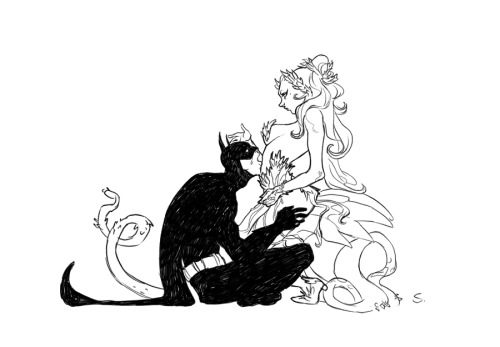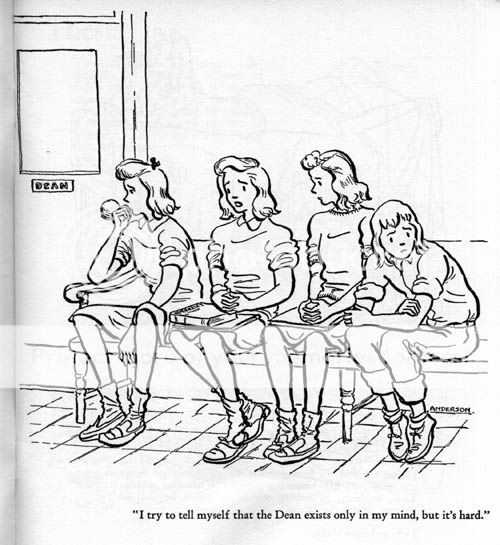Archive for March 31, 2009
Carnival of souls
March 31, 2009* The new Bat for Lashes album, Two Suns, is really something special, I think. It strikes me as a cross between OK Computer and Boys for Pele, and I’ve been listening to it in its entirety once or twice a day. The whole thing is now streaming online, so if you think it might be your cup of tea, give it a listen. (Via Pitchfork.)
* David Cronenberg is working on a sequel to Eastern Promises. I totally sympathize with the folks who want Dave to go back to gonzo body-horror, but it turns out he’s a terrific director of crackling, grim, violent (comparatively straightforward) thrillers who also seems intent on providing Viggo Mortensen with material that’s his equal, so I’m not complaining. (Hey Hollywood: If you must remake The Long Good Friday, there are better choices out there than Paul W.S. Anderson.)
* Tom Neely’s prepping a new edition of Brilliantly Ham-fisted, a collection of his comic-strip poems which I rather liked.
* Curt Purcell was stunned by Geoff Grogan’s Look Out!! Monsters. It’s a not uncommon reaction.
* CRwM reviews Let the Right One In, focusing on the truth behind Eli and Oskar’s relationship.
* When it comes to the trailer for Spike Jonze’s Where the Wild Things Are, I’m with Carles.
* Douglas Wolk prophesies the coming of the Celestial Jukebox, the “any song, in any order, available instantly anywhere” online music repository of our collective dreams–he says it’s inevitable, that its constituent parts are already here, and the question is simply whether it will be legal or not.
* The Hall of Cliche Super Heroes is a pretty great idea period, let alone a pretty great idea for a T-shirt. (Via JK Parkin.)
I am a 25 year old married man, college graduate, eventual grad school student. Got a good/stable job working with my father, active in my Church and all around nice guy. I also enjoy marijuana in moderation. It does not make me lazy. I do not have to have it. I only do it on one or two nights a week. But I enjoy it. It makes the nights I do it all the more enjoyable. It adds zest to life. I am a lover of film and music and it makes my viewing/listening all the more life affirming.
My husband and I often muse, while smoking pot, that the only thing we are doing wrong is breaking the law. If that is the only wrong you are committing it seems clear that it’s not your behavior that needs to be re-evaluated, but the law itself.
* Quote of the day #3:
“Let’s start with a premise that I don’t think a lot of Americans are aware of. We have five percent of the world’s population; we have 25 percent of the world’s known prison population. There are only two possibilities here: either we have the most evil people on earth living in the United States; or we are doing something dramatically wrong in terms of how we approach the issue of criminal justice.”
I wrote some stuff for some other sites
March 31, 2009Does making fun of geek culture make you more or less of a geek yourself? I think the answer is pretty obviously “more.” The following two projects of mine that went live over the past 24 hours are ample evidence.
First up, here’s the official, giant-sized debut episode of Marvel Superheroes: What The–?!, Marvel.com’s new stop-motion animated action-figure comedy series, which I co-wrote. It’s loaded with friends and former co-workers of mine: Animator and head writer Alex Kropinak, co-writer Jon Gutierrez, voice actors Ben Morse and Ryan Penagos. Also, MODOK throws up. (Spoiler alert!)
Next, over at Topless Robot I did another list feature about music from nerdy movies: 11 More Awesome Songs from Geek-Movie Soundtracks. I like to think this is one case of the sequel being every bit as strong as the original.
Lost thoughts extra: Ben time
March 31, 2009SPOILERS GALORE
I’ve been thinking a lot about what’s happening on Lost these days. You can’t know for sure until the show wraps up, but right now it seems like the actions of the characters–Sayid shooting Young Ben, for example, or Daniel’s disappearance, or the presence of Horace “I built Jacob’s cabin” Goodspeed–are edging closer and closer toward impacting the show’s central mysteries–the nature of the power struggle between the Hostiles/Others and the Dharma Initiative, the nature of the time fluctuations, the role of Jacob and so on. That’s gotten me in more of a theorizing mentality than I’ve been with the show in years. Actually, “theorizing” is too strong a word–speculating is more like it.
Anyway, my brother Ryan and I recently had a brief exchange about the show along these lines, and we thought people might get something out of it. We also continue making fun of Sayid, which is always a good time.
King Crimson – Walking on Air
March 31, 2009Have you ever wanted to hear Talking Heads do a “Jealous Guy”/”Don’t Let Me Down” mash-up for a laser Floyd show? Well, now you can.
Carnival of souls
March 30, 2009* Holy shit: Luba, Gilbert Hernandez, 600 page hardcover, coming soon.
* The great Josiah Leighton close-reads the opening sequence of Paul Pope’s Batman Year 100, one of the best action comics of the decade.
* This career-spanning interview with Daniel Clowes is pretty great, especially since you don’t see that many interviews with Daniel Clowes, much less of the career-spanning variety. (Via Tom Spurgeon.)
* He had some weed, so they shot him. (Via Ta-Nehisi Coates.)
* Weed is illegal, so they destroyed Mexico over it. (Jay Ackroyd.)
Comics Time: Jin & Jam #1
March 30, 2009Jin & Jam #1
Hellen Jo, writer/artist
Sparkplug Comic Books, 2008
36 pages
$5
The first thing I thought during my initial flip-through of Jin & Jam was “Boy, this person sure likes Taiyo Matsumoto.” Then I started reading from the beginning and the first thing I saw was an epigraph from Black & White, aka Tekkon Kinkreet, by Taiyo Matsumoto. So it’s not like Hellen Jo is trying to hide the influence, which emerges not just in the wiry art and leering character designs but in the plot itself, involving various paired-off tweenage characters gettin’ in trouble and stickin’ it to the man. But we’re not in Matsumoto’s sprawling dystopian future cityscape, we’re in a cramped, just-left-of-normal version of San Jose, California. And that’s where I start to detect another, subtler influence: Jaime Hernandez and the Locas of Love & Rockets. As we watch Jam, Hank, Jin, Ting, and Terng do the shiftless-layabout teenage-wasteland thing, we observe little details about their California culture: the junk-food diets, the bike-riding cops with bike helmets and short-shorts, the angry Korean Presbyterian preachers and so on. Meanwhile, the fact that the title of the book is Jin & Jam even though when we meet Jam she’s already paired off with Hank indicates that there will be some kind of emotional shift taking place, breaking up or truncating one friendship as another blossoms. We even start to see it happen by the end of the book: As Jin and Jam take a fantastical ride on a swing set under the stars, the faces of their “friends” literally vanish, leaving Jin & Jam as the only real people in the book’s final splash page. Is this Tekkon Kinkreet or Wigwam Bam or just a jack of both trades but master of neither? Too soon to tell, but are you not entertained regardless?
Seanmix – Favorite Cities: The Best of Azure Ray
March 29, 2009Sleep / Displaced / Rise / November / For the Sake of the Song / No Sings of Pain / Trees Keep Growing / Favorite Cities / The Drinks We Drank Last Night / Just a Faint Line / These White Lights Will Bend to Make Blue / Raining in Athens / Rest Your Eyes / Hold On Love / Other Than This World
Azure Ray are/were one of my all-time favorite bands. Among artists who were still a going concern this decade they actually are my favorite, them and Underworld. Azure Ray is/was singers/songwriters Maria Taylor and Orenda Fink, with production assists by Andy LeMaster. Taylor and Fink split up a few years back to pursue solo projects that I’d also recommend and songs from which I nearly included in this mix; happily, they recently announced that they’re writing and playing together again in hopes of putting the group back together, so if you like what you hear here and exhaust their four releases–Azure Ray, Burn and Shiver, November, and Hold On Love–there will hopefully be more in store.
When my love for a particular band is very intense it gets difficult for me to describe exactly what it is I love so much about it. That’s not the case for movies or comics or anything else, just music. I can say that Azure Ray play largely acoustic music with an electronic veneer, kind of folk-y, lots of delicate girl-girl harmonies, a touch of Southern gothic, lyrics about memory and longing. I think the best way to put it is that if I were a glass and Azure Ray were a tuning fork, the frequency of their emotional content would shatter me.
Carnival of souls
March 29, 2009* I haven’t talked about this yet I don’t think, but over the past little while a lot of my friends at Wizard lost their jobs. This includes the whole staff of Anime Insider, and over at the Wiz proper it includes David Paggi and Rachel Molino, the two remaining altcomix-interested staffers. This is all a bummer for various obvious reasons. My pal Rob Bricken has a nice eulogy for AI. On a similar note, I liked Douglas Wolk’s post on Blender, which was canceled the same day as Anime Insider.
* Tim O’Neil concludes his review-of-Kingdom-Come-by-way-of-a-bunch-of-different-posts by explaining “momentism” as a school of superhero writing. This is pretty goddamn dead on. During my years at Wizard, the search for iconic/badass/jaw-dropping moments in superhero comics, splash pages or action beats or lines of dialogue that functioned not just in getting across something necessary to the story but also in encapsulating just what makes Superhero So-and-So so cool/tragic/scary/inspiring/whatever, was absolutely paramount for writers and readers alike.
* Here are some more Caprica clips, replacing the set that was apparently yanked earlier last week. I’m still not watching them.
* Tom Kaczynski discusses Watchmen the comic and Watchmen the movie in terms of cool and hot media.
* Jog reviews a trio of recent comics of note: Jim and Jam, Sleazy Slice, and Rumbling.
* Renee French: still creepy.
* Jim Rugg has a blog! And he drew Klaus Nomi!
* I’ll never not be a sucker for nice compact drawings of Batman and his rogues gallery like this one from Doc Shaner (via Johnny Bacardi). Heck, that’s why I got Lego Batman last week.
* Torture is useless at producing actionable intelligence. One has to wonder what, then, the point of torture is.
Want a big long list of all the superhero-type comics I read these days?
March 28, 2009You’ll find one at the Savage Critic(s). I love lists.
King Crimson – Indiscipline
March 27, 2009Adrian Belew, ladies and gentlemen, one of the great unsung heroes of the last three decades of music.
Comics Time: First Time
March 27, 2009 First Time
First Time
Sibylline, writer
Alfred, Capucine, Jerome d’Aviau, Virginie Augustin, Vince, Rica, Olivier Vatine, Cyril Pedrosa, Dominique Bertail, Dave McKean, artists
NBM/Eurotica, 2009
108 pages, hardcover
$19.95
Gloria Leonard said that the difference between pornography and erotica is lighting; it stands to reason that in comics, the difference between pornography and erotica is linework. First Time, then, is definitely erotica. This collection of sexually graphic vignettes features high-class, high-quality European artists whose styles will be instantly familiar to readers of alt/art/lit comics here in the States, even if the artists themselves (most of them pseudonymous, I think) are not. But best of all, a couple of them are familiar. Yep, “Cyril Pedrosa” is indeed Three Shadows Cyril Pedrosa! And Dave McKean is indeed “Neil Gaiman” Dave McKean! Maybe it’s just me, but I think seeing cartoonists whose mainstream work you know and admire get smutty is one of life’s simple pleasures, like discovering the lovely but respectable actor you’re crushing on did an extensive nude scene back when everything was at its youngest and most pert.
Indeed, the reclamation of the erotic as something respectable comics creators can depict and respectable comics readers can discuss is something of a hobbyhorse of mine. Shouldn’t sex be something we tackle at least as often and as directly and with at least as much sophistication as we deal with violence and misery? Heck, shouldn’t it be something we tackle independently from violence in misery? This is a pretty terrific step in all those directions. In addition to bonafide critics’ darlings Pedrosa and McKean, every artist looks like they could have stepped out of a Petit Livre from Drawn & Quarterly or one of Fantagraphics’ Blab! storybooks or MOME guest spots.
Writer Sibylline seems to have either tailored the material to her collaborators or picked them to suit the material. “First Time,” a sweet story of a girl’s deflowering that comes with a funny twist ending, has an appropriately Top Shelf-ish vibe courtesy of the angular cartooning of artist Alfred, while the more self-indulgent topic matter of “Sex Shop” and “Fantasy” earn the more voluptuous, outwardly sexy curved lines of Capucine and Jerome d’Aviau respectively. “1+1″‘s story of a first-time girl-on-girl hook-up and the subsequent disappointment it engenders in one of its participants gets an animated look from artist Virginie Augustin, which nicely supports its initial whimsy and free-spiritedness and eventual heartbreak. “2+1”, with its tangle of bodies in a cramped apartment, slowly evolves from Tim Sale to Aeon Flux courtesy of artist Vince. Rica’s “Nobody,” the most Robin Bougie-ish of the stories what with its sex-doll subject matter, also boasts the most Robin Bougie-ish art, while Olivier Vatine’s “Club,” appropriately enough, reminds me of that New X-Men issue where Chris Bachalo helped reimagine the Hellfire Club as a strip joint in a tip of the hat to its NYC namesake. For those who’ve read the sweet, sensitive Three Paradoxes, Pedrosa’s aptly titled “Submission” may come as a shock, what with all the deep-throating and spanking and following orders to go look in the mirror with a mouth full of semen, but then again I think it was clear from that graphic novel’s bold visuals that Pedrosa could pull off pretty much anything. Dominique Bertail’s “Sodomy” has the most traditional sex comix look, I think, but its gender-reversal subject matter is strong enough that matter-of-factness is an apt stylilstic choice. Finally, McKean’s “X-Rated” combines manipulated film stills with cubist kama-sutra positioning for something that wouldn’t have looked out of place in a deleted Arkham Asylum scene where the Joker watched Batman get it on with Poison Ivy over the closed-circuit cameras. The whole project is a bit undercut by slightly wooden translation work from Joe Johnson, but only a bit. Overall it made me wish that more work like this was being produced. If you like your smut smart and your art sexy, seek this out.
Carnival of souls
March 26, 2009* Well, this is interesting. Normally I suppose I’d be up in arms over the news that Battlestar Galactica mastermind Ronald D. Moore’s script for the prequel to John Carpenter’s The Thing is getting a rewrite. But look who’s doing the rewriting: Eric Heisserer, whom longtime readers of ADDTF’s horrorblog incarnation may recognize as the author of the brilliantly frightening webfiction project Dionaea House. Obviously Heisserer hasn’t led the shuttering of a proposed Dionaea House film adaptation hold him down–he’s apparently also done some work on the remake/reboot of A Nightmare on Elm Street.
* Kiel Phegley speaks to incoming Daredevil writer Andy Diggle. The interview is short on details about the project, as you’d expect from PR for a book that hasn’t even begun yet, but I’m still interested insofar as Daredevil has somewhat improbably become Marvel’s benchmark of quality over the past few decades, and I’m hoping that Brian Bendis and Ed Brubaker’s excellent runs are followed up by something equally entertaining.
* Todd VanDerWerff’s weekly Lost review is worth a read as always; this time around he discusses something I surely noticed but hadn’t quite articulated for myself regarding the structure of last night’s episode. something that may have made it feel a bit less fresh than its immediate predecessors.
* Your quote of the day:
If I could ask any of the 3 most recent presidents just one question, the question would be:
“It’s well known that you tried illegal drugs at some point in your life. Would the world be a better place if you had gone to prison and gotten a permanent black mark on your record for that youthful experimentation? If not, then why are you so determined to send young men and women to prison for the same mistakes that you yourself made and then moved past?”
Lost thoughts
March 25, 2009SPOILER WARNING
* One of my favorite Lost-fandom running gags is whenever anyone talks about what a badass Sayid is, I give a quick rundown of every time this supposed badass has gotten his ass handed to him. Locke brained him when it looked like he’d fixed the radio, he got captured by Rousseau, the Others snuck past him and attacked the boat, he got captured by the Iraqi expat married to the woman he tortured in one of his flashbacks, he got captured by the Others in New Otherton, he got captured by the Others on the beach, he got captured by Locke in New Otherton, he got shot by his girlfriend who was Widmore’s double agent, he got shot by the mystery thugs who were chasing him and Sayid, he got captured by Jin and Radzinsky, and now, finally, he got captured by the bounty hunter lady with the big hair. So when an entire episode centers on the notion that being a ruthlessly efficient killing machine is the only thing Sayid is good at, I’m just like, “compared to what?”
* That said, I thought it was a fairly meaty episode, giving Sayid some explicit worldweariness that we haven’t seen from him in a while. It actually makes his relative profligacy with the ladies make a bit more sense. (For someone obsessed with the love of his life for years, he’s sure gotten a lotta tail before and since; in sheer numerical terms he’s slept with as many women on the show as Sawyer has.) It also makes perfect sense that he’d take this opportunity to kill young Ben, and that he’d feel both justified and totally disgusted about it.
* I assume “the Island isn’t done with Ben yet” and he’ll pull a Locke/Wolverine in short order. Otherwise we’ll have some Marty McFly-style fading out of existence to do for some of the character.s
* Yo, the promo for this week’s episode totally doctored Juliet’s line to Kate so it made it sound like she was telling Kate to stay away instead of making fun of the idea that she’d tell Kate to stay away! Dirty pool! And a much less interesting exchange than what we actually saw. Yay for the show, boo for the network promo people.
* I liked the idea that Ann Arbor, of all places, is the seat of a sinister conspiracy. When do you suppose is the last time a person namedropped “Ann Arbor” in order to intimidate someone?
* And when was the last time E.B. Farnum intimidated someone? Other than Richardson, I mean.
* So, I was entertained, but there were also some pretty rote bits. The bait-and-switch with the two Iraqi kids was something you could see coming a mile away (and something they already did with Eko and Yemi, but more powerfully and disturbingly and convincingly since they had to kill a person, not a chicken). So was the bit with Horace and the wirecutters and the handcuffs, which I’m pretty sure this show has done before but which you could also trace to the creepy Nazi’s clothes hanger in Raiders of the Lost Ark. Meanwhile, the source of Ben and Sayid’s falling-out was that Ben ran out of people for Sayid to kill? That was the big betrayal that made Sayid realize Ben was evil and manipulative all along? Also, some random bounty hunter from Guam can keep Sayid under wraps long enough to get him through airport security and on a plane? Pretty undercooked.
* The thing I appreciated the most was when Sawyer really did risk Sayid’s life, or at the very least his comfort and freedom, in order to preserve his own life with Juliet and the Dharma Bums. That’s precisely the right balance for his “100 days with the castaways/three years with Horace” life story to lead him to, and good for the show for acknowledging that in this way.
Carnival of souls
March 25, 2009* I don’t have any idea why, but apparently I never linked to my friend Kiel Phegley’s epic interview with Art Spiegelman. Done and done. Say what you will about Spiegelman’s blend of self-effacement and ego–saying nobody wanted what he was doing in Breakdowns with one breath, taking credit for Chris Ware, Richard Maguire, Alan Moore, and Scott McCloud with the next–but I just plain found it refreshing to hear a titan of comics say things like “I didn’t know much about manga at the time [I did Maus].” It happens! And this quote is a killer:
My experience with therapy is that it’s more like vomiting stuff up, finding things and just throwing them out. The process of making a work is like if you ran a movie of someone vomiting in reverse, you take the chunks and internalize them.
And so is this, holy moses is it ever:
My friend Tom DeHaven put it well. He’s a writer who did a novel called The Funny Papers – the Wizard audience might’ve seen his Superman novel. At some point he said, “Well, a writer is someone who enjoys having written,” and that seemed about right to me.
* And here’s Kiel’s interview with Guy Davis, really one of the great action-adventure cartoonists working today.
* There’s been a positive development in that weird Let the Right One In subtitle fiasco I linked to yesterday: Responding to fan outcry, the studio will be releasing an alternate version of the DVD with the theatrical subtitles intact; it will be labeled as such in the packaging’s fine print. However, they insist they will not accept exchanges, which ought to go over great. I expect they’ll be changing their tune, but for now, this will make it difficult for me to ask for this DVD for my birthday. (Via Dread Central.)
* The Vassar-centric cartoonist Anne Cleveland has died at the age of 92. This is sad, but in that bittersweet way that anyone who lives to such a ripe old age makes you feel, and also it gives me the excuse to post some lovely looking art by Cleveland and her collaborator Jean Anderson. (Art via Shaenon Garrity via Heidi MacDonald.)
* A new Runaways creative team of Kathryn Immonen and Sara Pichelli has been announced. I think one issue of Joss Whedon was enough to boot me off non-Brian K. Vaughan Runaways for good, but dang, Pichelli’s not going to make that an easy decision to maintain. (Art via Johnny Bacardi.)

* I’m starting to think Tim O’Neil’s promise to review Kingdom Come is an elaborate hoax, like Joaquin Phoenix’s hip-hop career. But this latest installment actually comes pretty close, discussing among other things the character of Magog, his design, and his modus operandi versus that of other traditional and ’90s-era heroes and anti-heroes. Tim’s post also raises one of the classic corporate-superhero questions–“Why doesn’t Batman or some Gotham cop kill the Joker?”–that lead to the “logical conclusions” superhero-comic subgenre we were discussing yesterday. Speaking of, Curt Purcell continues to question the utility of that label in the comments.
* Wow, seeing a couple of Complete Vintage Star Wars Action Figure sets up for sale makes me more tempted to blow thousands of dollars on toys than I’ve ever been in my life.
* Eric Reynolds Shelf Porn = MY GOD IT’S FULL OF STARS
Comics Time: Asterios Polyp
March 25, 2009Asterios Polyp
David Mazzucchelli, writer/artist
Pantheon, June 2009
344 pages, hardcover
$29.95
An extraordinarily easy book to read, Asterios Polyp is, I’m finding, a nearly equally extraordinarily difficult book to talk about. Frankly I think I just feel out of my depth. For example, cartoonist David Mazzucchelli has a long history of making art comics in Europe, and I’ve flipped through a few in the store or off my buddy Josiah’s shelf, but the only Mazzucchelli comics I’ve read from start to finish prior to this book are Batman Year One, Daredevil: Born Again, and that little comic with the spilled jar of ink he did for The Comics Journal Special Edition: Cartoonists on Cartooning. But hey, fine, I can fake it, I can certainly locate Asterios Polyp within the tradition of alternative comics. For exaple, it uses color and, to a certain extent, character design like a Dash Shaw webcomic or MOME contribution; it mixes imagery with external narrating text like Chris Ware, only with several orders of magnitude more room to breathe on the page, like Ware filmed in slow motion. That, I get.
What I’m having harder time with, where I feel really out of my depth, is in trying to locate the book’s story content. Asterios Polyp is a highly lauded, award-winning “paper architect,” i.e. a guy whose designs are awesome but have never actually been built, who divides his time between Manhattan and the Ithaca, NY university where he is a professor. We join his story already in progress, as a fire consumes his ratty, messy, porn(?)-soundtracked bachelor pad. Asterios does not pass Go, does not collect $200, proceeds directly from fleeing his apartment in the rain with his wallet and a handful of knicknacks and watching the fire department fight the fire down into the subway and back up and out at the Port Authority, where he takes a bus to the middle of nowhere and gets the first job he can find (as an auto mechanic) and crashpad he can find (renting a room from his boss at the auto shop). From there we bounce back and forth between revelatory events in the present day and key events in the life that led him there, mostly having to do with his ill-fated relationship with the talented but somewhat timid sculptor he was once married to.
In other words, it’s very Woody Allen, very Philip Roth, very New Yorker. A sophisticated urban aesthete unsuccessfully balances the life of the mind with the life of his weiner and then wonders where it all went wrong; his life is contrasted with that of the spirited younger woman he can never quite get a handle on and various other sophisticated urban aesthetes whose arrogance and eccentricity he deplores yet cannot see within himself. And there’s my problem: I know enough about that stuff to recognize the template, but I don’t know enough of it to know if it goes beyond using the template into wholesale swiping and/or rote recapitulation. The best I can do is say “Well, this reminds me somewhat of the Woody/Alan Alda bits in Crimes & Misdemeanors.” I’m simply not well-read enough in this area to comment beyond that. Ask me to speak authoritatively about the next Neil Marshall movie and I can probably handle that, but this? Donnie, you’re out of your element.
What I can say with confidence, however, is that I enjoyed that story immensely. And a big part of that is because this isn’t a Woody Allen film or a Philip Roth novel–it’s a comic, and there’s no mistaking it. Yeah, the basic story could be told in other ways, but if you wanted an illustration of that old saw that you should be able to look at a comic and determine why it’s a comic and not a movie pitch or a short story, look no further. Mazzucchelli clearly had a blast drawing this thing.
My favorite ambitious graphic novels of recent vintage have been pretty manic and information-heavy in terms of the visual approach–Theo Ellsworth’s Capacity and Josh Cotter’s Skyscrapers of the Midwest spring to mind, and even Dash Shaw’s Bottomless Belly Button feels dense and claustrophobic compared much of his other recent work, if only for the lack of color. Asterios Polyp, on the other hand, is airy and light from start to finish, like giving your eyeballs a breath of fresh air. There are all kinds of panel layouts, splash pages, and stand-alone images here, popping right off the big white pages, and the CMYK colors are just a pleasure to look at.
Meanwhile, it’s almost unspeakably clever. Mazzucchelli gives each major character and setting its own color scheme, that’s apparent from the start–Asterios is bright blue, while his wife Hana is bright pink. But oh, the places Mazzucchelli goes with that! By the time Asterios takes Hana to meet his mother and invalid father, he’s wearing a pink checkered jacket, while she has on a blue shirt. In a passage meant to illustrate how our memories slowly refine our original experiences “because every memory is a re-creation, not a playback,” Asterios’s remembered Hana slowly morphs from having a pink shirt on against a white background to wearing a blue shirt against a blue background. And in a much later scene which I’m going to try hard not to spoil, where the two encounter each other long after their divorce and after myriad transformative experiences, the color scheme is totally different–all oranges and greens. Meanwhile, “neutral zones” in both dreaming and waking life are yellow and purple. And let me assure you that as far as the use of color goes, that’s just the tip of the iceberg.
Then there are the countless clever references to the history and art of cartooning. Given our hero’s occupation and preoccupations, there are quite a few mini-essays on architecture, philosophy, design, music…and they’re drawn and lettered like something out of Understanding Comics. A Latina chef swats flies on the ceiling and looks like she could have gotten off the plane from Palomar yesterday, while her band’s drummer sports a “Los Bros” sticker on his drumkit. Asterios’s dapper in-his-youth father looks like he stepped out of a Seth comic. The Midwesterners who take Asterios in–Stiff Major and his zaftig wife Ursula, and no, Mazzucchelli is clearly not above having some Vonneguttian fun with names–could be thrown up on the screen in a Disney/Pixar production tomorrow. Hana I can’t quite put my finger on, but she’s got a distinct ’50s/’60s illustration vibe, part Charles Addams part something else I’m too slow to pick up. Asterios himself is given to standing in profile and holding a cigarette like Eustace Tilley holds his monocle. His teaching career reads like Art School Confidential from the professor’s perspective. (Student: “I’m thinking about adding fenestration to this planar surface…?” Asterios: “How about just putting a couple of windows in that wall?”)
None of this would matter, or at least it would matter very little, if the comic weren’t a series of emotional hooks and twists and high points and explosions, which it is. The dream sequences are uniformly strong, with one involving a flooded subway station-cum-dock so evocatively drawn–thick washes of purple ink, rough crosshatching for one of the first times in the whole book–that I could practically hear the echoing slosh of the water in the tunnels. Asterios’s unique, virtually constant headshape (how have I not talked about this until now?) essentially requires him to be drawn in profile, so the few times we see him turn toward us (again in a dream sequence, notably!) are stop-and-pay-attention moments. The book’s bravura sequence (you’ll hear about this a lot) condenses the couple’s entire life together into a series of snapshot images of Hana’s various movements and bodily secretions; here’s one case where my familiarity with this technique bred nothing but admiration for seeing it so well done. The ending…I’ll say I imagine it will be controversial and leave it at that, but I got a kick out of it.
The real knockout moment for me, though, came during the pivotal argument that stories like this inevitably include, the storm that built for years yet ultimately came out of nowhere and nothing was the same after that. You spend the build-up to it noticing that something is awry, something in the way Hana has been drawn, something in the way there seem to be two or three things going on at once in the interactions between Hana, Asterios, and the other characters involved (including a memorable little imp named Willy Ilium in the book’s Clare Quilty role). Once it gets going, once the pink-and-blue color scheme starts shifting appropriately and the linework and coloring get scratchier and choppier and angrier, you’re rooting for Hana all the way, you think that finally the beef you’ve been accumulating on her behalf is going to get the apocalyptic airing it deserves. And then…and then…BAM, a line you just did not see coming at all, making it all the more devastating, because after all, neither did Asterios. I think this particular exchange may open the book up to charges that it embraces the same sexism it nominally deplores in its characters, but to me it’s the human element that comes through, not the gendered one. I read this scene and said “My God” out loud on the train. (You really need to read the book to get what I’m talking about, I suppose, and it doesn’t come out until June so unless you somehow ended up with a review copy months ago like I did I guess that’s difficult, but do me a favor, bookmark this and come back later and see if you think I’m right, okay?)
I may not know ahhht, is I suppose what I’m saying, but I know what I like. And I like Asterios Polyp a lot. It’s certainly a book to savor. I suspect it’s a book to treasure. I guess it wasn’t that hard to talk about after all.
Carnival of souls
March 24, 2009* Eve Tushnet reviews the bloody blue bejesus out of Zack Snyder’s Watchmen here and here. (That second link is weird, but it should show you four separate posts on the movie.)
* Speaking of Watchmen, Curt Purcell continues to insist, Linda Richmon-like, that the “logical conclusions” of the superhero genre are neither logical nor conclusions. Discuss. Actually, I agree with Curt that “logical conclusion” is overstating the case a bit, since as he points out with a clever comparison of Dr. Manhattan to the Squadron Supreme’s Hyperion, there are any number of ways “what would superheroes really do?” can be taken. But I think he brushes it all off a bit too completely. Most the the superhero stories we’re discussing are self-contained; they can’t take place in the corporate shared universes that exist, like DC or Marvel’s, because they upset the delicate balancing act required by those universes. For example, Marvel prides itself on being a more “realistic” universe than DC’s, so you can’t have a President Nighthawk and you can’t have Reed Richards phase out fossil fuels by having us fill our tanks with Kirby Krackle instead. DC has a set hierarchy in terms of which superheroes are the biggest deals, so you can’t have a godlike supervillain like Black Adam just walk up to Batman and pull his head off, nor can you have Golden Age Flash be more popular than Wally West even though, as Tom Spurgeon once put it, that would sort of be like Babe Ruth coming out of retirement but people are still more interested in Derek Jeter. What the superhero stories that purport to take the genre to their “logical conclusions” do is take certain ideas inherent to the genre much, much further than the shared-universe structure could ever allow them to do without falling apart at the seams. In that sense they really would be “concluding” stories for those universes as we know them–which is why many of them are literally apocalyptic or Ragnarokian in nature even when removed from those universes. So there’s definitely something more to such stories than simply being “a tour-de-force that takes superheroes remarkably far in a relatively unusual direction”–in many cases, certainly in the better cases, they really would break the average superhero comic if they were attempted in that context. But of course that’s because of the various business considerations and weird historical quirks that led to the creation of the Marvel Universe and the ad hoc assembly of the DC Universe, and thence what was considered by superhero creators and fans to be “normal,” not anything inherent to the genre per se.
* Here are seven clips from Caprica, the upcoming Battlestar Galacitca prequel-pilot-movie. I’m not watchin’ ’em but I hope they’re good.
* Wow, terrible news about shoddy subtitle translations on the DVD version of Let the Right One In. (Via Jason Adams.)
* Finally, here are some pictures of Patti Smith, who is attractive in them.
(via)
(via)
Lick My Love Pump
March 24, 2009To me, “Lick My Love Pump” is the single funniest gag in This Is Spinal Tap, because it’s just so very, very, very, very, very, very stupid. The other night I came across it on the Internet and laughed so hard my stomach muscles got sore and I hurt my throat, and this is after seeing it however many times in the past.
Here’s how to play the song on the piano.
Gossip Girl thoughts
March 24, 2009* This ep was something of a return to form, no? Right down to the old-school Gossip Girl nature of the central shenanigans: Nate being rich, Vanessa being insufferably bohemian, Blair wearing lingerie and wrecking shop, Chuck oozing in and out of Serena’s room while making gross comments, Lily the Former Nine Inch Nails Groupie and Rufus the Human Turtleneck being bad at romance, etc. It felt much more like Gossip Girl than that unfortunate school play/secret sex society tag-team last week.
* And yet I still find I don’t have much to talk about. I mean, we’re not exactly in “series finale of Battlestar Galactica territory here.” God, how funny would that be? Still, “All of this has happened before, and all of it will happen again” is a pretty good mantra for Gossip Girl.
* Once again, with that grifter guy already back off the show after just two episodes, you see how fast GG burns through storylines, particularly ones that involve guest stars. I wonder how long Grandfather and Cousin Trip will last.
* The thing I enjoyed the most about last night’s episode was that Nate’s family estate was filmed at Old Westbury Gardens, a lovely lovely old mansion with enormous and elaborate gardens here on Long Island that the Missus and I visit fairly frequently. She recognized it immediately.
* I also like how Serena slapped Dan for having sex with a teacher in the costume closet during the school play, then immediately thought the whole thing was hilarious, because that’s what I thought!
Carnival of souls
March 23, 2009* My pal Josiah Leighton returns to close-read a few action sequences within an inch of their lives. First up is a Chris Ware action sequence (seriously) from Quimby the Mouse, and also a scene from Jason Pearson’s Body Bags; this is the first time in human history that these two comics have been discussed in tandem. Next up is a Rob Haynes spread from Daredevil. Nobody does what Josiah is doing better than Josiah does it.
* Tom Spurgeon presents the writer Ben Schwartz’s take on Alan Moore’s recent pronouncements regarding comics the art form and comics the industry. it’s gratifying to see somebody else describe those comments as dictionary-definition “ignorant,” and who knows, maybe the way Schwartz tackles it will get people to consider whether Moore’s similar comments regarding Hollywood filmmaking are different not in kind but in degree, rather than taking both trains of thought and just saying “hey, he’s an artist not a critic, and plus I agree, and plus calm down Sean.” Ahem.
* I report this out of a sense of obligation rather than any actual interest, but Sam Raimi says he still wants to do Evil Dead 4 and says he’d drag Bruce Campbell with him. Typically, MTV Movies Blog oversells this by blaring EXCLUSIVE and headlining it “Raimi insists Bruce Campbell and he will be back for a fourth ED film” when Raimin in fact does no such thing. This is annoying, and perhaps actively misleading given how firmly Campbell recently came out against the prospect of doing ED4. Please stop doing stuff like that, MTV Movies Blog.
* Jason Adams highlights some, uh, highlights from the Battlestar Galactica finale. I’ve enjoyed seeing which storylines hit various fans the hardest, and this is no exception.
* When T-shirt blogging and real-life horror blogging collide: Ha’aretz reports on some of the gruesomely violent, even warcrime-endorsing T-shirts being made by members of the Israeli military to commemorate the completion of various training courses. I bet you I could find a lot more stories along these lines on behalf of virtually every nation and political persuasion on Earth, sadly. It seems like a rich vein to tap given how amenable T-shirts are to sloganeering of the most vile variety. (Via Andrew Sullivan.)
* Finally, the second installment in an irregular series: The Best of Bowie Loves Beyoncé!






Remember: The prettiest stars are always in your Bowie Loves Beyoncé tumblelog.
Carnival of Battlestar/Vastly less brief Battlestar Galactica thoughts
March 23, 2009SPOILERS FOR THE ENTIRE FRAKKING SERIES AHEAD
* First, this seems like as good a place as any to collect the links to all my Battlestar Galactica posts for this final half-season.
* Episode 4.5.1: Sometimes a Great Notion
* Episode 4.5.2: A Disquiet Follows My Soul
* Episode 4.5.4: Blood on the Scales
* Episode 4.5.7: Someone to Watch Over Me
* Episode 4.5.8: Islanded in a Stream of Stars
* Episode 4.5.9: Daybreak Part 1
* Episode 4.5.10: Daybreak Part 2
* Here’s a link to that promo for Battlestar Galactica: The Plan, the Jane Espenson-written (boo), Edward James Olmos-directed (yay) BSG movie that will air sometime this fall. It’s about what was going on with the Cylons all this time. Amusingly it doesn’t seem to feature Lucy Lawless as D’Anna/Three, which should be funny to see them try to explain. I wonder what it will reveal.
* Unless they work it in during post, apparently it won’t really address Daniel, the mysterious 7th Cylon model whom Ellen revealed to have been destroyed by Cavil: Ron Moore says that was just a throwaway bit of backstory to give Cavil some Cain/Abel mojo, and that he was taken aback to see speculation take off that Daniel was Starbuck’s deadbeat musician father or something. Obviously, if you were counting on getting an explicit resolution to that plot point in the finale, you were disappointed. But even before I read this interview, I just assumed Daniel was, in fact, Starbuck’s dad, making Starbuck, in fact, a hybrid (or “hylon,” in the parlance of our times), and that this was never going to be explicitly confirmed, just like in Revenge of the Sith (in another opera house scene, amusingly) when the Emperor implies that he was responsible for Anakin’s immaculate conception but never comes right out and says it, yet that’s obviously what we’re supposed to take away from it. We’re grown-ups, we can handle that. I still may prefer believing that to not believing it, I dunno. I read a really interesting interview with Harley Peyton, one of the writers for Twin Peaks, along those lines, where he was like (paraphrasing here) “oh, we never had a master plan that led up to that final image, we came up with that sitting in the writers’ room working on the final episode, but by all means concoct a master plan based on what ended up on the screen–that’s the important thing, not what we were or weren’t thinking all along.”
* You can read some post-finale interviews with Ron Moore at SciFi Wire and with the Chicago Tribune’s Maureen Ryan, probably the biggest BSG blogger around. Her interview is just one part of a massive post-finale post including some details about which episodes will be expanded in the DVDs, additional interview snippets with various cast and crew members, and her own thoughts.
* I’ve continued to think about–you might almost say “dwell on”–the finale, and the more I do so the more impressed I get. I don’t think even the Sopranos finale made me feel this way. What’s really sticking in my gut is trying to get there from here, trying to mentally and emotionally link the early episodes where there were terrorist attacks in restaurants and arguments about abortion and rigged elections and such with a finale where the two warring societies essentially give up, disperse, and fade away into history, becoming barely a memory to anyone. Talk about a finale that makes you reevaluate the entire series! It’s just about as gutsy as I’ve seen television get.
* I think this is due to what Malcolm Sheppard says in this thoughtful post (link via Jim Henley):
In the end, both cultures collapse and their bearers don’t resist it. This is a hard pill to swallow because we’ve been acculturated (ha!) to believe there’s a transcendental value in cultural continuity, that a cultural collapse is by nature apocalyptic, and that it won’t happen to us, but none of these things are necessarily true.
In much the same way that Starbuck’s greatest fear was to be forgotten, our greatest fear as a culture is the same thing. We cling to the narrative of human progress that shows a steady build toward knowledge and freedom from the Stone Age to the present day, ignoring any number of separate strains and cultural-evolution cul-de-sacs along the way, even within Western culture (we barely made it out of ancient Christianity’s dark-age deathgrip!). Our great collective horror story is the apocalypse, brought about by any number of factors–nuclear war, biological weapons, disease, climate change, aliens, technology run amok, zombies, you name it–but always with the same result: the story of humanity coming to an abrupt end. We care about the survivors of such stories at least as much for whether or not they survive to continue telling that story as we do for their survival in and of itself. Naturally we saw Battlestar Galactica in that same light, and so did the show’s characters, desperately attempting to perpetuate the social and political institutions that characterized their lives before the fall. For them to say “enough” and willingly fade away…that is a hard, hard pill to ask your audience to swallow, but I’m glad I’ve been respected enough by the creators to be asked to do so. It’s certainly made me re-think things a lot more than a traditional truce or victorious ending would have. This was a truce and a victory in its own unique way.
* And now for some barely coherent musings on “God” and Its role in the finale.
* It’s interesting to see how different people’s expectation for the show’s ending was from what the show had been basically promising to deliver all along, which was a heaping helping of honest-to-gods mysticism. I think you’ll see several different cultural forces converge in terms of people who vocally don’t like “God”‘s direct involvement in the finale in the persons of Head Six, Head Baltar, and Kara:
* First, there’s your basic internet-fandom contingent, which insists that everything must be SERIOUS BUSINESS and have logical explanations that can be “solved” like a puzzle; to the extent that “God” is a supernatural force, it is less serious and less solvable than, say, a science-based explanation like hallucinations or brain implants from the Final Five. These folks appear to have believed that all the god-talk all along was a fake-out, that the show didn’t really mean it. For a lot of them, having the “divine” play a role in the finale, any finale, is automatically a deus ex machina in the pejorative sense–you see that phrase everywhere.
* Second, I believe there’s a goodly chunk of hardcore SF buffs to whom the word “angel” is automatically STUPID in all caps. The Tor.com roundtable on the episode has to be the ne plus ultra of this particular subgenre–the very thought of how the Head characters and Starbucks resurrection were explained seems to have sent them into caps-locked apoplexy. Seriously, you really have to see it. Again, an active role for the divine is an automatic deus ex machina. NB: Please forgive me if I’m mischaracterizing the participants in the Tor roundtable as serious science fiction experts–I really don’t know, I’m just assuming given the site. Maybe they’re like AICN talkbackers, I dunno. Certainly the fact that many of them watched it in a group, screaming at the screen all the while, reminds me more of Internet fandom than people who read Foundation a lot. Also NB: Not all serious SF fans are like that. For example, Jim Henley, for whom speculative fiction is but one of many many topics about which he is much much smarter than I am, liked that aspect of the finale, and by extension the entire series, better than pretty much any others. He also locates it in a rich tradition of SF literature about humanity, divinity, and the spirit.
* Third, there are people who misinterpret a lot of what was actually said and depicted in the finale and base their most vehement criticism on that. For example, there’s a popular notion that the episode was explicitly Luddite, with the Fleet’s survivors reject all technology, not just jettisoning their ships. This was demonstrably untrue.
* Another example: People who felt like the closing montage of increasingly sophisticated humanoid robots here on present-day Earth (well, “Earth”) meant that the whole point of the show was that Ron Moore is warning us against making robots. (I think someone said exactly that in the Tor.com roundtable.) To me, it’s pretty obvious that the robots here were used the same way the Cylons were used all along: as symbolic shorthand for everything the human and Cylon cultures did wrong, not just “technology run amok,” let alone “don’t make androids, they’ll kill you.”
* Another example, and perhaps the most fundamentally mistaken: Over religiosizing/spiritualizing “God” and “the angels” as presented in the finale. To hear some people talk about it, you’d think Jesus of Nazareth entered “All Along the Watchtower” into the nav computer and jumped the ship, or that human and Cylon reached a truce by proclaiming their shared belief that there is no god but Allah and Muhammad is His Prophet. But the “God” posited by Battlestar Galactica is a very, very weird one, far both the Biblical/Koranical God of our understanding and the gods of the Colonials and the One True God of the Cylon Centurions and skinjobs. In his speech in the CIC, Gaius Baltar argues that “God” is “beyond good and evil–we invented those.” Head Baltar later tells Head Six that “God” “doesn’t like that name,” implying that It is something very different than the deities worshipped by Colonials, Cylons, and Earthlings alike–perhaps even another physical species, albeit one so advanced that its doings look like magic to us. Meanwhile, take the behavior of the “angels” themselves. We never saw what Head Baltar and Caprica Six got up to, but Head Six’s primary angelic activity was giving Gaius Baltar handjobs and encouraging him to save his own bacon by getting other people killed (and occasionally saving their lives, but only when it suited her). The two Head characters were both pretty smarmy and sinister, even at the end. And Kara? She was an “angel” who had no idea that she was an angel, and was pretty miserable–borderline crazy–over it. These are not traditional Gabriel or Christ figures by any stretch of the imagination, and it’s both reductive and incorrect to imagine them as such.
* Related: My biggest eureka moment since watching the finale came (unsurprisingly!) when I read the great Todd VanDerWerff’s review of the episode, in which he said this:
Battlestar has always had a weird strain of Gnosticism running through it (particularly in Baltar’s sermons), so the notion of God as a sometimes altruistic and sometimes destructive force that operates independently and can never be fully comprehended by our characters managed to plug into the series mythos fairly well.
I think I literally cheered and smacked my head when I read that. Why? Because one of the hardest parts of the last two half-seasons to swallow was Baltar’s religious…whatever you’d call it. Conversion? Hucksterism? You couldn’t even tell. At times he seemed utterly, even frighteningly sincere, and then next time you saw him he’d be his old scheming cowardly manwhore self. You’d see invisible Head Six feeding him his lines, even physically manipulating his body to get him to rise up after a beating from a Marine in one episode, and then she’d disappear for half a season. But most importantly, you’d get mixed messages in his sermons themselves. The two that really hit home with me were the one from last half-season where he told his followers that God loved them because they were all perfect–a total absolution of responsibility, really some breathtaking theology–and then the one after the discovery of the ruined Earth where he says we’re right to be angry with God, that God in fact owes us an apology. Discovering that God is really “God”–some inscrutable force that isn’t the omnipresent, omniscient, omnipotent, omnibenevolent deity we know, but is instead “beyond good and evil,” “sometimes altruistic and sometimes destructive” as VanDerWerff puts it–squares the circle with all this contradictory information and makes the Cult of Baltar finally make sense.
* The final group of naysayers that I can see at work don’t really have an underlying philosophical or aesthetic program in terms of their objections: They just don’t like all the coincidences and “fate” stuff that added up to create what happened in the finale. Racetrack’s dead hand hitting the button to nuke the Colony…Starbuck using the music to enter the right coordinates…a second Earth…Hera as mitochondrial Eve…Baltar’s speech being enough for sociopathic Cavil to change his mind, and Adama and the rest of the gang buying that change…the Chief/Cally/Tory storyline bubbling up again just in time to destroy the truce and ignite the final confrontation…Starbuck being resurrected to get the fleet to Earth-1 and Earth-2 and then just disappearing…the opera house visions perfectly syncing up to the chase for Hera in the Galactica…it’s all just a bit too much for these folks to swallow. I think I have the least beef with this objection than with any of the other. Battlestar Galactica has never been the most subtle of shows, but up until now its bluntness has generally been in the service of entropy, atrocity, catastrophe, depression, disillusion, failure, things falling apart. All of a sudden you’re required to be okay with everything lining up just so to create…a happy ending?
* Now, don’t get me wrong, I think this is simplifying it too much. The “happy ending” that would have been easiest for the show to do would have been the truce between the Fleet and Cavil’s Cylons actually working out–they get the resurrection technology, we get left alone, everyone goes their separate ways, the end. The show complicated that by having Chief fuck it all up, straight-up murdering Tory for straight-up murdering Cally, who I’m given to understand is one of fandom’s least favorite characters. Then there’s all the complicating details about the role of the divine and the approach to technology that I listed above. Then there’s the fact that the “happy ending” can only be understood as such if you put aside cultural conditioning regarding the importance of cultural continuity. So it really isn’t just a bunch of too-neat, sledgehammer-subtle coincidences forcing us where the show wants us to go.
* In fact, the biggest risk the show takes in the finale is sending us in so different a direction in the first place. The audience of Battlestar Galactica has been trained to expect the worst–and now, in the finale, we’re required to accept the best, however briefly it ends up lasting. In fact I’ve seen many complaints about that alone–that it’s too happy an ending, that it’s like kumbaya or something, that not enough non-“evil” characters die, and so on. I think that’s the toughest thing for many people to swallow: Not only must you accept the coincidences or fate or whatever you call it, but you must accept them on behalf of an ending as emotionally wide-open and optimistic as those vistas of our unspoiled planet. You’re either in the mood to resign yourself to hope, or you’re not. I am.











